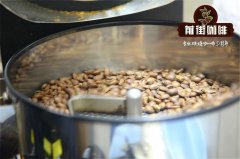Five major coffee producing areas in El Salvador Starbucks selected coffee beans from San Marcellino Farm in El Salvador

Professional coffee knowledge exchange more coffee bean information please follow the coffee workshop (Wechat official account cafe_style)
El El Salvador, located in the center of Central America, is one of the oldest coffee birthplaces in the world, rich in Bourbon, Pacas and Pacamara coffee varieties. Coffee estates are located in the hills and volcanic slopes with the most fertile soil, mainly concentrated in Alotepec, Apaneca, El B á lsamo, Chichontepec, Tepaca and Cacahuatique, covering an area of 161000 hectares. Due to the special volcanic topography and soil, Salvadoran coffee has a unique flavor, mellow taste, moderate sweet and sour, rich aroma, and charming tonality.
El Salvador is the smallest country in Central America, only about 3/5 the size of Taiwan. Although it is small, it has 25 volcanoes, large and small, which can bring a lot of ash and fertile soil. But they have to face the threat of active volcanoes every day, which makes local residents both love and fear.
Salvadoran coffee has five major producing areas (Apaneca, Central Belt, Chichontepec, Tecapa & Cacahuatique Mountain Range), mostly distributed in the volcanic ash-covered mountain slopes or plateau areas at an altitude of 1200 meters. October to February of the following year is the coffee harvest and harvest season. The coffee beans produced by it belong to Arabica species, including Bourbon bourbon and Pacas Pacas. It can be divided into three grades according to the altitude, namely SHG (Strictly High Grown), SG (High Grown) and SC (Central Standard).
A brief history of coffee in El Salvador:
In the mid-19th century, El Salvador became independent from Nicaragua after the disintegration of the Union, and its cash crops were mainly locust blue plants.
It was a crop used to make indigo dye, and it was not until the invention of chemical dyes in the mid-19th century that the land was converted to growing coffee.
Because of the support of the aristocracy and the background of militarized rule, the political situation is relatively stable, and the coffee industry has also led to the development of non-governmental industry.
In the 1880s, it even became the fourth largest coffee producer in the world. The civil war broke out in 1980, which had a great impact on coffee production and trade.
Altitude classification:
El Salvador still uses altitude classification, which has nothing to do with quality or production and marketing experience.
There are three levels of topography alone.
How to distinguish the elevation grades:
Strictly High Grown (SHG): planted more than 1200 meters above sea level.
Hight Grown (HG): over 900m above sea level.
Central Standard: plant more than 600m above sea level.
Salvadoran coffee features:
El Salvador coffee is full-bodied, full-bodied and sweet, with aromas of dried fruit, citrus, chocolate and caramel.
It is most famous for its sweet and supple acidity, which is very symmetrical and harmonious.
Qianjie coffee: Guangzhou bakery, the store is small but a variety of beans, you can find a variety of unknown beans, but also provide online store services. Https://shop104210103.taobao.com
Important Notice :
前街咖啡 FrontStreet Coffee has moved to new addredd:
FrontStreet Coffee Address: 315,Donghua East Road,GuangZhou
Tel:020 38364473
- Prev

Piedra de Candela Kendra Coffee from four major coffee producing areas in Panama has special historical flavor.
Professional coffee knowledge exchange more coffee bean information please follow the coffee workshop (Wechat official account cafe_style) Panamanian coffee growing area: unique characteristics of fertile soil: volcanic soil is rich in minerals. Its geological structure can filter moisture ideal altitude: coffee grows at an average altitude of 1500 meters above sea level ideal temperature: lowest temperature average 18 degrees Celsius; maximum
- Next

Panama Carmen Manor introduces how to make Panamanian coffee? Flavor characteristics of Panamanian Coffee
For more information on coffee beans, please follow Coffee Workshop (official Wechat account cafe_style) Carmen Manor, a family business that prides itself on the continuous production and export of high-quality raw coffee beans. In the 1950s, Efrain and Carmen Franceschi began to grow high-quality Arabica coffee on the estate, and today their children and grandchildren take over the management of the estate.
Related
- Does Rose Summer choose Blue, Green or Red? Detailed explanation of Rose Summer Coffee plots and Classification in Panamanian Jade Manor
- What is the difference between the origin, producing area, processing plant, cooperative and manor of coffee beans?
- How fine does the espresso powder fit? how to grind the espresso?
- Sca coffee roasting degree color card coffee roasting degree 8 roasting color values what do you mean?
- The practice of lattes: how to make lattes at home
- Introduction to Indonesian Fine Coffee beans-- Java Coffee producing area of Indonesian Arabica Coffee
- How much will the flavor of light and medium roasted rose summer be expressed? What baking level is rose summer suitable for?
- Introduction to the characteristics of washing, sun-drying or wet-planing coffee commonly used in Mantenin, Indonesia
- Price characteristics of Arabica Coffee Bean Starbucks introduction to Manning Coffee Bean Taste producing area Variety Manor
- What is the authentic Yega flavor? What are the flavor characteristics of the really excellent Yejasuffi coffee beans?

